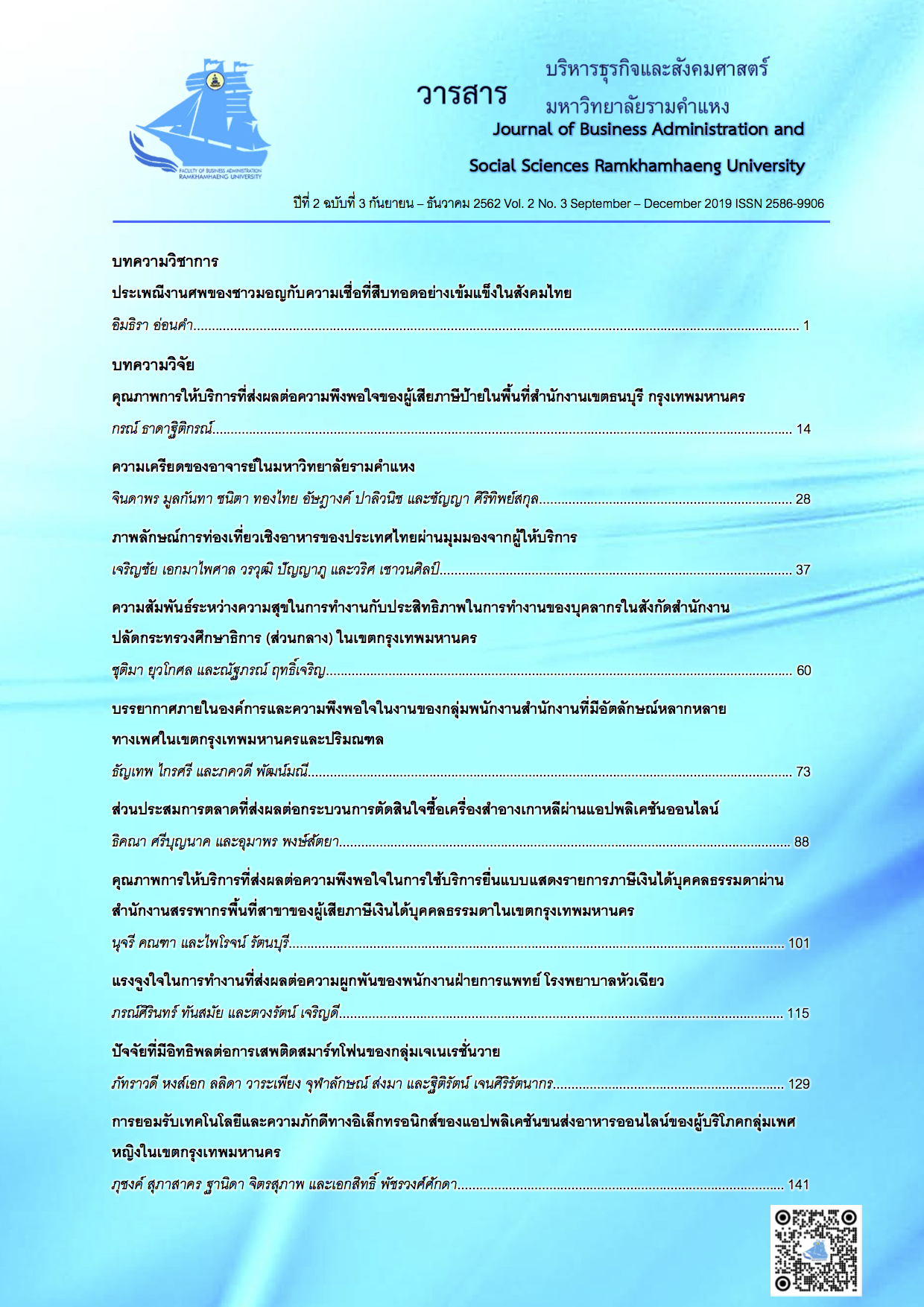Factors influencing Smartphone Addiction Behavior in Generation Y
Main Article Content
Abstract
In this research investigation, the researchers examine the relationship between demographic factors, environmental factors, smartphone use behavior, and predictive factors affecting smartphone addiction behavior. The study was conducted on the sample population of 197 generation Y smartphone users using the method of convenient sampling. Data were collected using an online questionnaire. Then the respondents who had smartphone addiction behavior were selected in accordance with Smartphone Addiction Scale.
Findings showed that the factors affecting smartphone addiction behavior were the environmental factor in the aspect of social influence and the smartphone user behavior factor. The aspects of the period of use per day and the purpose of use positively correlated with smartphone addiction behavior. However, the personal factor in the aspect of self-regulation did not correlate with smartphone use behavior. Three factors could predict smartphone addiction behavior of the members of the sample population. The factor of smartphone use behavior in the aspect of the purpose of use exhibited an efficiency in the explanation or prediction at the highest level at 28.1 percent (β = 0.351). Next in descending order were the environmental factor in the aspect of social influence with an efficiency in the explanation or prediction at 12.0 percent and smartphone use behavior in the aspect of the period of use per day with an efficiency in the explanation or prediction at 5.1 percent.
Article Details
เนื้อหาและข้อมูลในบทความที่ลงตีพิมพ์ในวารสารบริหารธุรกิจและสังคมศาสตร์ มหาวิทยาลัยรามคำแหง ถือเป็นข้อคิดเห็นและความรับผิดชอบของผู้เขียนบทความโดยตรง ซึ่งกองบรรณาธิการไม่จำเป็นต้องเห็นด้วย หรือร่วมรับผิดชอบใดๆ
บทความ ข้อมูล เนื้อหา รูปภาพ ฯลฯ ที่ได้รับการตีพิมพ์ในวารสารบริหารธุรกิจและสังคมศาสตร์ มหาวิทยาลัยรามคำแหง ถือเป็นลิขสิทธิ์ของวารสารบริหารธุรกิจและสังคมศาสตร์ มหาวิทยาลัยรามคำแหง หากบุคคลหรือหน่วยงานใดต้องการนำบทความทั้งหมดหรือส่วนหนึ่งส่วนใดไปเผยแพร่ต่อ หรือเพื่อกระทำการใดๆ จะต้องได้รับอนุญาตเป็นลายลักษณ์อักษรจากวารสารบริหารธุรกิจและสังคมศาสตร์ มหาวิทยาลัยรามคำแหง ก่อนเท่านั้น
References
ชีวรัตน์ ปราสาร. (2559). ความชุกของภาวะอาการ Nomophobia ในกลุ่มนิสิตนักศึกษาที่ใช้สมาร์ทโฟน ในมหาวิทยาลัยภาครัฐ. วิทยานิพนธ์วิทยาศาสตรมหาบัณฑิต, จุฬาลงกรณ์มหาวิทยาลัย.
ตั๋น นิลมาติ และวิโรจน์ มโนพิโมกษ์. (2558). ปัจจัยที่มีผลต่อพฤติกรรมติดการใช้งานเครือข่ายสังคมออนไลน์ ของนิสิตระดับปริญญาตรี มหาวิทยาลัยเกษตรศาสตร์ วิทยาเขตบางเขน, วารสารสหวิทยาการวิจัย: ฉบับบัณฑิตศึกษา, 4(1), 157-165.
ปทิตตา ทองเจือพงษ์. (2559). ปัจจัยและผลกระทบของการเสพติดสมาร์ทโฟนต่อประสิทธิภาพการทำงาน โรคกลัวไม่มีสมาร์ทโฟนใช้. วารสารระบบสารสนเทศด้านธุรกิจ, 2(3), 40-54.
ปรีชญา แม้นมินทร์. (2558). ค่านิยมและการใช้สื่อของเจเนอเรชั่นเบบี้บูมเมอร์ เอ็กซ์และวายไทย. ดุษฎีนิพนธ์นิเทศศาสตรดุษฎีบัณฑิต, จุฬาลงกรณ์มหาวิทยาลัย.
พรจันทร์ วงค์คุ้มสิน. (2557). การตอบสนองของผู้บริโภคที่มีต่อการตลาดแบบไวรัลเปรียบเทียบระหว่าง กลุ่มเบบี้บูมเมอร์ส เจเนอเรชั่นเอ็กซ์ และเจเนอเรชันวาย. วิทยานิพนธ์บริหารธุรกิจมหาบัณฑิต, สถาบันบัณฑิตพัฒนบริหารศาสตร์.
วรพร เอกมนัส. (2558). ปัจจัยที่มีความสัมพันธ์และอิทธิพลเชิงบวกต่อการเสพติดสมาร์ทโฟน ของพนักงานในกลุ่มบริษัทผู้ผลิตมีเดีย A ในกรุงเทพมหานคร. วิทยานิพนธ์บริหารธุรกิจมหาบัณฑิต, มหาวิทยาลัยกรุงเทพ.
วุฒิ สุขเจริญ และอรุณลักษณ์ วิทยวิจิน. (2559). การศึกษาพฤติกรรมการตอบแบบสอบถามของผู้บริโภคในการวิจัยการตลาด. วารสารอิเล็กทรอนิกส์การเรียนรู้ทางไกลเชิงนวัตกรรม, 6(2), 110-126.
ศุภณัฐ รัตนเสรีวงศ์. (2559). การเปิดรับสื่อโฆษณาเกมกับพฤติกรรมการตัดสินใจเล่นเกมออนไลน์บนโทรศัพท์มือถือ. วิทยานิพนธ์นิเทศศาสตรมหาบัณฑิต, มหาวิทยาลัยกรุงเทพ.
สมโภชน์ เอี่ยมสุภาษิต. (2550). ทฤษฎีและเทคนิคการปรับพฤติกรรม (พิมพ์ครั้งที่ 6). กรุงเทพฯ: สำนักพิมพ์แห่งจุฬาลงกรณ์มหาวิทยาลัย.
สมาน ลอยฟ้า. (2557). พฤติกรรมการใช้อินเทอร์เน็ตของผู้ใหญ่ในชนบท. อินฟอร์เมชั่น, 21(2), 18-28
สำนักงานพัฒนาธุรกรรมทางอิเล็กทรอนิกส์ (องค์การมหาชน). (2562). รายงานผลการสำรวจพฤติกรรมผู้ใช้อินเทอร์เน็ตในประเทศไทย ปี 2561. สืบค้นเมื่อ 30 กันยายน 2562, จาก https://www. etda.or.th/publishing-detail/thailand-internet-user-profile-2018.html
สำนักงานสถิติแห่งชาติ. (2561). สรุปผลที่สำคัญ การสำรวจการมีการใช้เทคโนโลยีสารสนเทศและการสื่อสารในครัวเรือน พ.ศ. 2561 (ไตรมาส 1). สืบค้นเมื่อ 19 กันยายน 2562 จาก http://www. nso.go.th/sites/2014/DocLib13/ด้านICT/เทคโนโลยีในครัวเรือน/2561/ict61-สรุปผลที่สำคัญ_Q1.pdf
Cochran, W. G. (1963). Sampling Techniques. New York: John Wiley & Sons.
Gökçearslan, Ş., Mumcu, F. K., Haşlaman, T., & Çevik, Y. D. (2016). Modelling smartphone addiction: The role of smartphone usage, self-regulation, general self-efficacy and cyberloafing in university students. Computers in Human Behavior, 63, 639-649.
Hong, F.-Y., Chiu, S.-I., & Huang, D.-H. (2012). A model of the relationship between psychological characteristics, mobile phone addiction and use of mobile phones by Taiwanese university female students. Computers in Human Behavior, 28(6), 2152-2159.
Jeong, S.-H., Kim, H., Yum, J.-Y., & Hwang, Y. (2016). What type of content are smartphone users addicted to: SNS vs. games. Computers in Human Behavior, 54, 10-17.
Kwak, J. Y., Kim, J. Y., & Yoon, Y. W. (2018). Effect of parental neglect on smartphone addiction in adolescents in South Korea. Child Abuse Neglect, 77, 75-84.
Van Deursen, A., Hegner, S., & Kommers, P. (2015). Modeling habitual and addictive smartphone behavior. The role of smartphone usage types, emotional intelligence, social stress, self-regulation, age, and gender. Computers in Human Behavior, 45, 411-420.
Vora, L. J. (2015). Evolution of mobile generation technology: 1G to 5G and review of upcoming wireless technology 5G. International Journal of Modern Trends in Engineering and Research, 2(10), 281-290.


